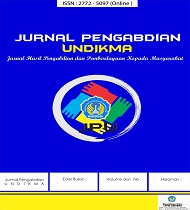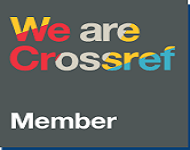An Investigation of EFL Preservice Teachers’ Attitudes and Motivations in Developing a Digital Learning Video
DOI:
https://doi.org/10.33394/jk.v8i2.4933Keywords:
EFL Preservice Teachers, Attitudes, Motivations, Digital Learning Video.Abstract
This research is aimed at investigating EFL preservice teacher’s attitudes and motivations in developing a digital learning video and the difficulties found in developing a digital learning video. The research was conducted at University of Muhammadiyah Prof. Dr. Hamka. There are 67 EFL preservice teachers who became the participants taken by purposive sampling technique. A mixed method was used. The questionnaire was distributed to all participants to respond to their attitudes and motivations, and nine participants were invited to have an individual interview. A descriptive statistic was used to analyze the questionnaire data and a description and image analysis was utilized to analyze the open-ended questions and the interview data. The results show that (1) the EFL preservice teachers’ attitudes in developing a digital learning video are in the higher level as the mean of their responses from four items ranging between 3.16 to 3.21, (2) the EFL preservice teachers’ motivations in developing a digital learning video are also in the higher level in which the mean of their responses ranged from 3.12 to 3.36, and (3) the difficulties faced in developing a digital learning video include: skills of using applications, providing materials, software capability, confidence, and time availability. Therefore, the implications cover the learning video quality produced by EFL preservice teachers to attract students’ attention to learn English better, the variety of video editing applications used in overcoming students’ learning boredom, and encouraging EFL preservice teachers to continue learning and practicing to create and edit the videos better.
References
Adriani, D., Lubis, P. K. D., & Triono, M. A. A. (2021). Development of Digital Learning Video Based on the Cyberlink Power Director Program in the Era of Learning Freedom in Education Economics Courses. 6th Annual International Seminar on Transformative Education and Educational Leadership (AISTEEL 2021), 804–808.
Atilboz, N. G. (2021). Enhancing Preservice Teachers’ Understanding of Circulation System Concepts, Attitude and Motivation. Uluslararası Eğitim Araştırmacıları Dergisi, 0–2. https://doi.org/10.52134/ueader.989718
Atmojo, A. E. P. (2021). EFL teachers’ online teacher professional development experiences amidst the COVID-19 pandemic: Practices and perceptions. Englisia: Journal of Language, Education, and Humanities, 9(1), 1. https://doi.org/10.22373/ej.v9i1.9127
Calderón, A., Meroño, L., & MacPhail, A. (2020). A student-centred digital technology approach: The relationship between intrinsic motivation, learning climate and academic achievement of physical education pre-service teachers. European Physical Education Review, 26(1), 241–262. https://doi.org/10.1177/1356336X19850852
Campbell, L. O., & Cox, T. (2018). Digital Video as a Personalized Learning Assignment: A Qualitative Study of Student Authored Video using the ICSDR Model. Journal of the Scholarship of Teaching and Learning, 18(1), 11–24. https://doi.org/10.14434/josotl.v18i1.21027
Creswell, J. W. C. J. D. (2018). Research design: qualitative, quantitative, and mixed methods approaches. In Sage (5th ed., Vol. 53, Issue 9). Sage. http://www.elsevier.com/locate/scp
Dahliana, S. (2019). Students’ Motivation and Responsive Pedagogy in Language Classroom. Englisia Journal, 6(2), 75. https://doi.org/10.22373/ej.v6i2.4601
Deesomsak, R., Paudyal, K., & Pescetto, G. (2013). Durham Research Online EXCEPTIONALLY. Language Learning Journal, 41(3), 251–253. http://dx.doi.org/10.1037/xge0000076
Fidan, M. (2018). The Usage of Video Blog (vlog) in the “School Experience†Course: The Opinions of the Pre-service Teachers. Journal of Education and Future, 13, 161–177.
Gentile, M. (2019). Digital Videos and Teacher Education: A Research-Training Framework (Issue June). 14th conference reader, Prague: Center for Higher Education Studies.
Graziano, K. J. (2018). Preservice Teachers’ Comfort Levels with Technology in an Online Standalone Educational Technology Course. Journal of Teaching and Learning with Technology, 7(1), 70–86. https://doi.org/10.14434/jotlt.v7i1.23492
Guido, R. M. D. (2018). Attitude and Motivation towards Learning Physics. 2(11), 2087–2094. http://arxiv.org/abs/1805.02293
Handayani, E. U., Utami, R. L., & Tamsil, I. M. (2021). How to Create Effective and Efficient Naḥwu Media with Short Videos Based on the Camtasia Application? In ALSUNIYAT: Jurnal Penelitian Bahasa, Sastra, dan Budaya Arab (Vol. 4, Issue 1, pp. 15–28). https://doi.org/10.17509/alsuniyat.v4i1.29232
Hashim, H. (2018). Application of Technology in the Digital Era Education. International Journal of Research in Counseling and Education, 1(2), 1. https://doi.org/10.24036/002za0002
Laksmi, N.K.P, Yasa, I.K.A, Mirayani, K. A. M. (2021). the Use of Animation Video As Learning Media for Young. Universitas Pendidikan Ganesha, 42–52.
Lowenthal, P. R., Borup, J., West, R. E., & Archambaullt, L. (2020). Thinking Beyond Zoom: Using Asynchronous Video to Maintain Connection and Engagement During the COVID-19 Pandemic. Elite English and Literature Journal, 28(2), 383–391. https://doi.org/10.24252/elite.v7i1a6
Maru, M. G., Nur, S., & Lengkoan, F. (2020). Applying video for writing descriptive text in senior high school in the covid-19 pandemic transition. International Journal of Language Education, 4(3), 408–419. https://doi.org/10.26858/ijole.v4i3.14901
Merkt, M., Hoppe, A., Bruns, G., Ewerth, R., & Huff, M. (2022). Pushing the button: Why do learners pause online videos? Computers and Education, 176(October 2021), 104355. https://doi.org/10.1016/j.compedu.2021.104355
Moreno-Guerrero, A. J., RodrÃguez-Jiménez, C., Gómez-GarcÃa, G., & Navas-Parejo, M. R. (2020). Educational innovation in higher education: Use of role playing and educational video in future teachers’ training. Sustainability (Switzerland), 12(6). https://doi.org/10.3390/su12062558
Mu’min, U. A. (2019). Peran Teknologi Informasi dalam Bidang Pendidikan (E-education). Al-Afkar, Journal for Islamic Studies, 2(1), 104–119. https://doi.org/10.31219/osf.io/ycfa2
Mulhayatiah, D., Sinaga, P., Rusdiana, D., Kaniawati, I., & Suhendi, H. Y. (2021). Pedagogical and professional physics teacher training: Why hybrid learning is important? Journal of Physics: Conference Series, 1806(1), 0–6. https://doi.org/10.1088/1742-6596/1806/1/012036
Noetel, M., Griffith, S., Delaney, O., Sanders, T., Parker, P., del Pozo Cruz, B., & Lonsdale, C. (2021). Video Improves Learning in Higher Education: A Systematic Review. In Review of Educational Research (Vol. 91, Issue 2). https://doi.org/10.3102/0034654321990713
Önal, A. (2019). An exploratory study on pre-service teachers’ reflective reports of their video-recorded microteaching. Journal of Language and Linguistic Studies, 15(3), 806–830. https://doi.org/10.17263/jlls.631520
Patricia Aguilera-Hermida, A. (2020). College students’ use and acceptance of emergency online learning due to COVID-19. International Journal of Educational Research Open, 1(July), 100011. https://doi.org/10.1016/j.ijedro.2020.100011
Pokhrel, S., & Chhetri, R. (2021). A Literature Review on Impact of COVID-19 Pandemic on Teaching and Learning. Higher Education for the Future, 8(1), 133–141. https://doi.org/10.1177/2347631120983481
Prastikawati, E. F. (2021). Pre-service EFL teachers’ perception on technology-based formative assessment in their teaching practicum. ELT Forum: Journal of English Language Teaching, 10(2), 163–171. https://doi.org/10.15294/elt.v10i2.47965
Raja, R., & Nagasubramani, P. C. (2018). Impact of modern technology in education. Journal of Applied and Advanced Research, S33–S35. https://doi.org/10.21839/jaar.2018.v3is1.165
Rohayati, D., & Rachmawati, E. (2021). The Impacts of Creating Youtube Video Project to Facilitate Students ’ Critical Thinking. ENGLISH REVIEW: Journal of English Education, 9(2), 323–332. https://journal.uniku.ac.id/index.php/ERJEE/article/view/4360/2569
Saed, H. A., Haider, A. S., Al-Salman, S., & Hussein, R. F. (2021). The use of YouTube in developing the speaking skills of Jordanian EFL university students. Heliyon, 7(7), e07543. https://doi.org/10.1016/j.heliyon.2021.e07543
Susantini, E., Indana, S., Isnawati, I., & Sayitri, S. D. (2020). Developing Instructional Video to EnhanceBiology Pre-Service Teachers’Metacognitive Skills. 95(Miseic), 147–150. https://doi.org/10.2991/miseic-19.2019.35
Syafiq, A. N., Rahmawati, A., Anwari, A., & Oktaviana, T. (2021). Increasing Speaking Skill through YouTube Video as English Learning Material during Online Learning in Pandemic Covid-19. Elsya : Journal of English Language Studies, 3(1), 50–55. https://doi.org/10.31849/elsya.v3i1.6206
Theelen, H., van den Beemt, A., & den Brok, P. (2019). Using 360-degree videos in teacher education to improve preservice teachers’ professional interpersonal vision. Journal of Computer Assisted Learning, 35(5), 582–594. https://doi.org/10.1111/jcal.12361
Vagg, T., Balta, J. Y., Bolger, A., & Lone, M. (2020). Multimedia in Education: What do the Students Think? Health Professions Education, 6(3), 325–333. https://doi.org/10.1016/j.hpe.2020.04.011
Valtonen, T., Hoang, N., Sointu, E., Näykki, P., Virtanen, A., Pöysä-Tarhonen, J., Häkkinen, P., Järvelä, S., Mäkitalo, K., & Kukkonen, J. (2021). How pre-service teachers perceive their 21st-century skills and dispositions: A longitudinal perspective. Computers in Human Behavior, 116(November 2020), 1–9. https://doi.org/10.1016/j.chb.2020.106643
van Alten, D. C. D., Phielix, C., Janssen, J., & Kester, L. (2020). Self-regulated learning support in flipped learning videos enhances learning outcomes. Computers and Education, 158(July), 104000. https://doi.org/10.1016/j.compedu.2020.104000
Wijaya, T. T., Ying, Z., Purnama, A., & Hermita, N. (2020). Indonesian students’ learning attitude towards online learning during the coronavirus pandemic. Psychology, Evaluation, and Technology in Educational Research, 3(1), 17–25. https://doi.org/10.33292/petier.v3i1.56
Downloads
Additional Files
Published
How to Cite
Issue
Section
Citation Check
License
License and Publishing Agreement
In submitting the manuscript to the journal, the authors certify that:
- They are authorized by their co-authors to enter into these arrangements.
- The work described has not been formally published before, except in the form of an abstract or as part of a published lecture, review, thesis, or overlay journal.
- That it is not under consideration for publication elsewhere,
- That its publication has been approved by all the author(s) and by the responsible authorities tacitly or explicitly of the institutes where the work has been carried out.
- They secure the right to reproduce any material that has already been published or copyrighted elsewhere.
- They agree to the following license and publishing agreement.
Copyright
Authors who publish with JK agree to the following terms:
- Authors retain copyright and grant the journal right of first publication with the work simultaneously licensed under a Creative Commons Attribution License (CC BY-SA 4.0) that allows others to share the work with an acknowledgment of the work's authorship and initial publication in this journal.
- Authors are able to enter into separate, additional contractual arrangements for the non-exclusive distribution of the journal's published version of the work (e.g., post it to an institutional repository or publish it in a book), with an acknowledgment of its initial publication in this journal.
- Authors are permitted and encouraged to post their work online (e.g., in institutional repositories or on their website) prior to and during the submission process, as it can lead to productive exchanges, as well as earlier and greater citation of published work.
Licensing for Data Publication
-
Open Data Commons Attribution License, http://www.opendatacommons.org/licenses/by/1.0/ (default)

This work is licensed under a Creative Commons Attribution-ShareAlike 4.0 International License.







